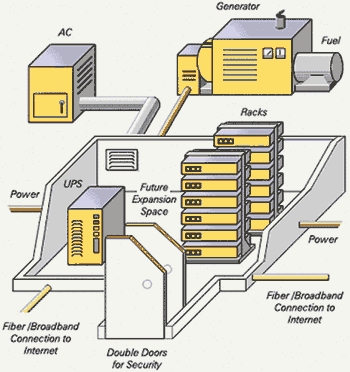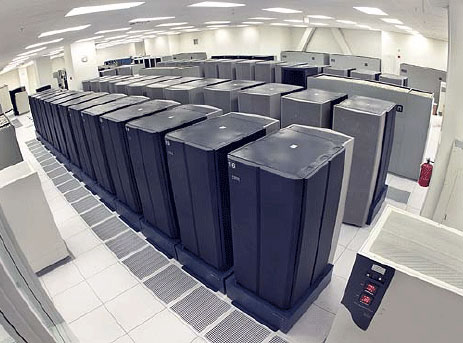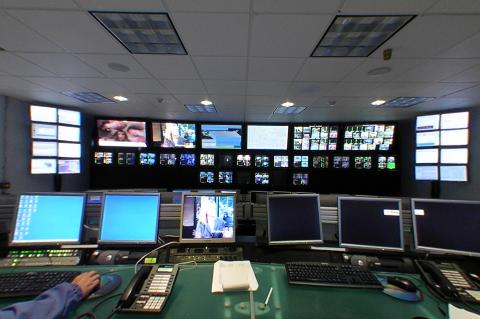Datacenters - Where the real stuff happens...
Status: Just notes so far
Last changed: Saturday 2015-01-10 18:31 UTC
Abstract:
Noise, heat and thus the need for an air-conditioned environment, structured under-floor cabling, redundancy power circuits, fire distinction through gas, equipment monitoring, physical access control, peering, hands and eyes support through 24/7 on-site personal, hundreds of gigabits bandwidth through many different carriers which run their own fibre backbones around the globe, multi-homing, carrier neutral hosting (not any datacenter provides for this), managed services, etc. Those terms are just a selection that goes with DCs (Data Centers). This page covers many different aspects with regards to datacenters from a customers perspective i.e. a company that does equipment housing and peering at large scale -- renting space for own equipment (racks, servers, SANs, etc.), installing own equipment in secured areas (private rooms, cages, etc.) and connect to several carrier backbones -- actually, things the random ISP (Internet Service Provider) does.
|
Table of Contents
|
  
Datacenter
The Players
To picture it, there are just a few players involved that makes the
whole DC (Data Center) shebang easy to understand:
Datacenter
The datacenter itself provides space — whole 19" racks, cages and
private rooms. A datacenter usually does not sell space less than a
whole 19" rack. It also provides power and cooling.
The building containing the datacenter looks/feels pretty much like a
fortress (barred windows, every inch inside and outside is covered by
CCTV, etc.). The datacenter operator itself does not care about fibre
backbones nor about the provision for hardware e.g. random 1U server.
Carrier
Carriers are those who own a fibre backbone. They do not care about
the air-conditioning in the datacenter or a particular 19" rack and
stuff like that. The only thing most carriers care about is extending
their global net of fibre cables and monitoring it. For the most part,
carriers are telcos e.g. the British Telecom is, amongst other things,
what is considered a carrier in datacenter terms.
Internet Service Provider
Those are connected to n carriers (with n > 0) which means even if one
carriers backbone fails (e.g. ship's anchor destroys a cable), the ISP
can still get I/O (Input/Output) from/to the Internet if he is
connected to x carriers (with x > 1).
In datacenter terms, ISPs must not necessarily be what most of us
think — an ISP provides Internet connection to end-users. An ISP can
simply provide connectivity to customers which house their equipment
within the datacenter. However, an ISP can do both — provide Internet
to end-users and provide connectivity for datacenter customers.
Datacenter Customer
This is what most of us are. A company can rent space from the
datacenter, put its own equipment on this space and buy connectivity
from an ISP. The space bought from the datacenter usually starts with
whole 19" racks, then cages and at the upper end we have private
rooms.
In case one just needs one or two servers colocated in a datacenter,
then he should rather ask an ISP for an all-in-one package — space
for 5Us plus connectivity. There is no need to become a dedicated
datacenter customer for as little as 5Us.
As of now (February 2008), the minimum costs for a 19" rack plus
10Mbit/sec committed bandwidth (95% rule) come for around 2000 euros
per month (rack rented from the datacenter, 800x800x2000 mm with doors
and lock).
The connectivity for this case is mostly single-homed i.e. the
datacenter customer is connected to an ISP which is then connected to
several carriers for redundancy reasons. However, a datacenter
customer may directly connect to one or more carriers and use dynamic
routing (BGP (Border Gateway Protocol)). However, that increases costs
and complexity dramatically and is mostly not recommended if the need
for bandwidth is less than 100Mbit/sec (again, 95% rule).
Glossary
Open Systems Interconnection
Packet vs Circuit switched
Packet Switched
Two major packet switching modes exist; connectionless packet
switching, also known as datagram switching, and connection-oriented
packet switching, also known as virtual circuit switching. In the
first case each packet includes complete addressing or routing
information. The packets are routed individually, sometimes resulting
in different paths and out-of-order delivery. In the second case a
connection is defined and preallocated in each involved node before
any packet is transferred. The packets include a connection identifier
rather than address information, and are delivered in order.
Switching / Routing
Peering
Autonomous Systems
Ein autonomes System (AS) ist eine Ansammlung von IP-Netzen, welche
als Einheit verwaltet werden und über ein gemeinsames (oder auch
mehrere) internes Routing-Protokoll (IGP) verbunden sind. Dieses Netz
wiederum kann sich aus Teilnetzen zusammensetzen. Ein AS steht unter
einer gemeinsamen Verwaltung, typischerweise von einem Internet
Service Provider (ISP), einer internationalen Firma oder einer
Universität. Autonome Systeme sind untereinander verbunden und bilden
so das Internet.
Point of Presence
Exchange
Local-loop unbundling
Hosting Location
In-House
http://en.wikipedia.org/wiki/Point_of_Presence
Colocation
Connectivity
Single Connection
Multi-homed
Billing
Burstable Billing
Committed Information Rate
IP Address Space
|





